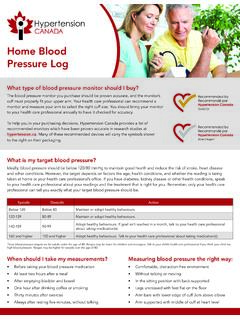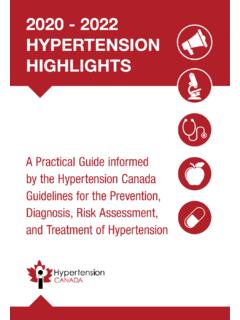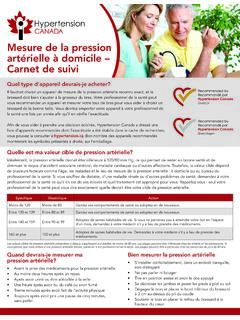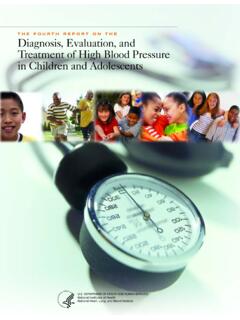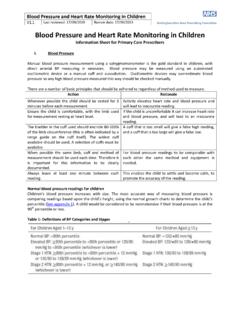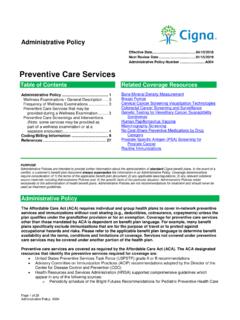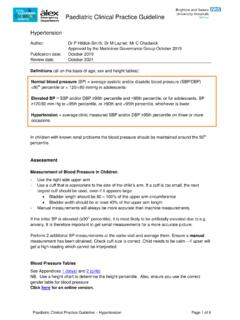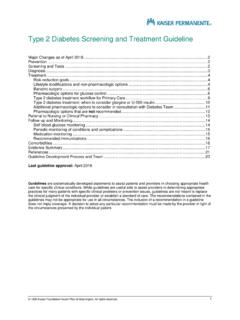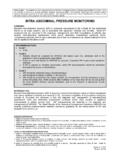Transcription of 2020 HYPERTENSION HIGHLIGHTS
1 A Practical Guide informed by the HYPERTENSION Canada Guidelines for the Diagnosis, Risk Assessment, Prevention, and Treatment of Hypertension2020 HYPERTENSIONHIGHLIGHTS Arm bare and supported Use a cuff size appropriate for your arm Middle of the cuff at heart level Lower edge of cuff 3 cm above elbow crease Sitting position Back supported Do not talk or move before or during the measurement Legs uncrossed Feet flat on the floorAccurate diagnosis begins with accurate measurement: blood PRESSUREMEASUREMENT TECHNIQUE1 HYPERTENSION 2020: HIGHLIGHTSThe HYPERTENSION Canada Guidelines are the nation s clinical practice guidelines for the management of HYPERTENSION . Developed by an expert volunteer network, the Guidelines are evidence-based, rigorously reviewed, and updated regularly to keep Canada s health care professionals informed of best-practices in HYPERTENSION booklet HIGHLIGHTS the most critical and widely relevant aspects of the HYPERTENSION Canada Guidelines.
2 Beginning with proper measurement techniques for diagnosis and advancing through treatment and follow up, this booklet serves as a practical guide for health care full Guidelines with supporting evidence, which also address complex specialty issues, can be accessed at Practical Guide informed by the HYPERTENSION Canada Guidelines for the Diagnosis, Risk Assessment, Prevention, and Treatment of Hypertension2020 HYPERTENSIONHIGHLIGHTS2 PATIEN T E VA LUATIO NI. MEASUREMENTThe use of standardized measurement techniques and validated equipment is recommended for all blood pressure (BP) methods. Automated office blood pressure (AOBP) Non-automated (manual) office blood pressure (Non-AOBP) Home blood pressure Monitoring (HBPM) Ambulatory blood pressure Monitoring (ABPM)Are you measuring correctly?Accurate diagnosis begins with accurate measurement. Evidence demonstrates that routine manual BP readings obtained in clinical practice are, on average, higher than when standardized measurement devices are used.
3 Inaccuracies in BP measurement can have clinical consequences such as incorrect diagnosis, misclassification of cardiovascular risk, or improper dosage of antihypertensive using electronic upper arm devices is preferred over auscultation. If electronic devices are unavailable, be sure to implement the recommended standardized technique for non-AOBP measurement. Preferred method for in-office measurementPreferred out-of-office methods for diagnosisIs arm size an issue?In patients with large arm circumference, when standard upper arm measurement methods cannot be used, validated wrist devices (utilized with arm and wrist supported at heart level) may be used for blood pressure is important to note that wrist devices are for estimation and not recommended for exact TECHNIQUE FOR AUTOMATED OFFICE blood pressure (AOBP) Measurements should be taken in a sitting position with the back supported using a validated device known to be accurate.
4 BP should be taken in both arms on at least one visit and if one arm has a consistently higher pressure , that arm should be used for BP measurement and interpretation. A cuff with an appropriate bladder size for the size of the arm should be chosen: bladder width should be close to 40% of the arm circumference and length should cover 80-100% of the arm circumference. The arm should be bare, supported, and kept at heart level. The lower edge of the cuff should sit 3 cm above the elbow crease with the bladder centred over the brachial artery. The patient s legs should be uncrossed with feet flat on the floor. There should be no talking and the room should be quiet. The device should be set to take measures at 1-to 2-minute intervals. The first measurement should be taken to verify cuff position and validity of the measurement. The patient should be left alone after the first measurement while the device automatically takes subsequent readings.
5 The average BP as displayed on the electronic device should be recorded, as well as the arm used and whether the patient was supine, sitting or Threshold for diagnosis:A mean SBP >135 mmHg or DBP >85 TECHNIQUE FOR NON-AUTOMATED OFFICE blood pressure (NON-AOBP) Measurements should be taken with a device known to be accurate. BP should be taken in both arms on at least one visit and if one arm has a consistently higher pressure , that arm should be used for BP measurement and interpretation. A recently calibrated aneroid device or sphygmomanometer should be used. Ensure the device is clearly visible at eye level. A cuff with an appropriate bladder size for the size of the arm should be chosen: bladder width should be close to 40% of the arm circumference and length should cover 80-100% of the arm circumference. The arm should be bare, supported, and kept at heart level. The lower edge of the cuff should sit 3 cm above the elbow crease with the bladder centred over the brachial artery.
6 The patient should rest comfortably for 5 minutes prior to the measurement in the seated position with their back supported. The patient s legs should be uncrossed with feet flat on the floor. There should be no talking and the room should be quiet. The first reading should be discarded and the latter two threshold for diagnosis:A mean SBP 140 mmHg and/or DBP 90 for Diagnosis in Diabetes:A mean SBP 130 mmHg and/or DBP 80 note:Record BP to the closest 2 mmHg on the sphygmomanometer, as well as the arm used and whether the patient was supine, sitting or standing. Record the heart vs. StandingThe seated BP is used to determine and monitor treatment standing BP is used to examine for postural hypotension, which may modify About Auscultation? Increase pressure rapidly to 30 mmHg above the level at which the radial pulse is extinguished. Place the bell or diaphragm of the stethoscope gently and steadily over the brachial artery.
7 Open the control valve so that the rate of deflation of the cuff is approximately 2 mmHg per heart beat. The systolic level is the first appearance of a clear tapping sound (phase I Korotkoff). The diastolic level is the point at which the sounds disappear (phase V Korotkoff). In the case of arrhythmia, additional readings with auscultation may be required to estimate the average systolic and diastolic pressure . Isolated extra beats should be ignored. Note the rhythm and pulse :If Korotkoff sounds continue as the level approaches 0 mmHg, listen for when the sound becomes muffled to indicate the diastolic the cuff partially inflated for too long will make sounds difficult to hear. Leave 1 minute between readings for optimal results. 6 HOME blood pressure MONITORINGHome blood pressure (home BP) monitoring can be used in the diagnosis of HYPERTENSION , and monitoring on regular basis should be considered for hypertensive patients with: Diabetes mellitus Chronic kidney disease Suspected non-adherence Demonstrated or suspected white coat effect BP controlled in the office but not at home (masked HYPERTENSION )If white coat or masked HYPERTENSION is suggested by home BP, it should be confirmed by repeat home or ambulatory BP monitoring before treatment decisions are Home SeriesWhite coat or sustained HYPERTENSION values should be based on duplicate measures, morning and evening for seven days.
8 First day values should be the ResultsHypertension Canada offers free downloadable blood pressure logs for health care professionals and patients at BP threshold for diagnosis:SBP >135 mmHg or DBP >85 mmHg should be considered elevated and associated with increased overall mortality year, with your health care professional, review the technique for measuring your My target blood pressure at home is less than:I use my: Left Armsystolicdiastolic/mmHGDateTimeComment sHeart Rate(beats/min)BP Reading #1BP Reading #2 SystolicDiastolicSystolicDiastolicJune 15 Sample Morning8:00 at 9 Evening8:00 1 EveningDay 2 EveningDay 3 EveningDay 4 EveningDay 5 EveningDay 6 EveningDay 7 EveningAverage day 2 to day 7 What type of blood pressure monitor should I buy?The blood pressure monitor you purchase should be proven accurate, and the monitor s To help you in your purchasing decisions, HYPERTENSION Canada provides a list of recommended monitors which have been proven accurate in research studies at What is my target blood pressure ?
9 Ideally, blood pressure should be below 120/80 mmHg to maintain good health and reduce the risk of stroke, heart disease SystolicDiastolicActionBelow 120 Below 80120-13980-89140-15990-99160 and higher 100 and higherThese blood pressure targets are for adults under the age of 80. Ranges may be lower for children and teenagers. Talk to your child s health care professional if you think your child has high blood pressure . Ranges may be higher for people over the age of 80 Home blood Pr essure LogWhen should I take my measurements? Before taking your blood pressure medication At least two hours after a meal After emptying bladder and bowel One hour after drinking coffee or smoking Thirty minutes after exercise Measuring blood pressure the right way: Comfortable, distraction-free environment Without talking or moving In the sitting position with back supported Ar m bare with lower edge of cuff 3cm above elbow Ar m supported with middle of cuff at heart level7 HYPERTENSION Canada s Device Recommendation Program Refer patients to HYPERTENSION Canada s list of devices validated as accurate at Home blood pressure monitors will begin to carry these logos on their packaging in 2018.
10 Have your patients look for the following logos to ensure their home BP monitor is valid and has been verified by HYPERTENSION Canada. Both Gold and Silver ratings are accepted as devices meet the highest and most current international standard for blood pressure measurement devices meet the highest international standards available prior to the most recent blood pressure MONITORINGA mbulatory blood pressure monitoring (ABPM) can be used in the diagnosis of HYPERTENSION and should be considered when an office-induced increase in BP (white coat effect) is suspected in treated patients with: BP that is not below target, despite receiving appropriate chronic anti-hypertensive therapy Symptoms suggestive of hypotension Fluctuating office BP readingsThe magnitude of changes in nocturnal BP should be taken into consideration when determining whether to prescribe or withhold drug therapy based upon ambulatory BP monitoring.
